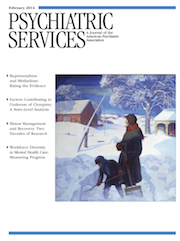To the Editor: Routine surveillance of disease incidence is a core function of public health programs (
1). Surveillance systems for mental disorders, however, remain underdeveloped despite strong temporal variation in the incidence of these disorders. Recently Google, the most commonly used search engine in the world, launched “Google Trends.” This Web site allows the public to gather statistics on queries made to the
Google.com search engine. To the extent that depression—a key risk factor for suicide—and suicidal ideation presage an increased risk of suicide completion, surveillance of Google Trends queries may assist with focused bursts of suicide prevention efforts. We tested whether suicide-related Google searches predict the monthly incidence of completed suicides. We examined England and Wales because of their publicly available suicide database and their high societal cost of premature death from suicide ($9.2 billion in 2009) (
2).
We obtained data on suicide incidence for January 2004 to December 2010, the longest series that overlaps with Internet-based suicide queries. We defined suicide by using conventional
ICD-10 classification schemes. We used as independent variables the monthly Internet-based queries by individuals in England and Wales for a series of search terms that have been shown to be related to suicide ideation (
3,
4). We examined three distinct sets of terms: suicide methodology (suicide; suicide and methods), depressive symptoms (suicide and depression; depression; depression and help), and suicide help (suicide; help). To statistically control for temporal patterns in suicide (for example, seasonality), we applied rigorous time-series routines (
5). [More details about the time-series routines are included in an online
data supplement to this letter.] We further controlled for the unemployment rate and Google searches in the news, which often peak after suspected suicides of popular personalities (for example, singer Amy Winehouse) but may not signal increased help seeking or depression.
For the three searches that included the term “depression,” we found a positive relation with search volume and suicide in that month. The strongest positive relation occurred between the Google Trends query for “depression and help” and suicide incidence in the same month (coefficients at lag 0 months=.004, standard error [SE]=.001, p=.002). We estimate that Google searches statistically accounted for a 7% increase in suicides during months in which search volume for “depression” increased. However, none of the Internet searches predicted the incidence of suicide in the following month. Moreover, we found no relation between searches for “suicide” or “suicide and methods” and suicide incidence. [Results are further detailed in the online
data supplement.]
We caution against inferring an individual’s Internet search behavior, depressive symptoms, and suicide risk from our population-level tests. Temporal fluctuations in Google searches are indicators of a population-level interest, which cannot shed light on individual differences in suicide risk. In addition, our findings of a positive relation between Internet search volume for “suicide and depression” and completed suicide in the same month cannot definitively establish that suicide-related searches precede suicide completion. Nevertheless, our findings indicate that current surveillance efforts for suicide may benefit from real-time use of Google-based Internet searches for depression.
Acknowledgments and disclosures
This study was supported by a National Institutes of Health Fellowship (NOT-OD-09-107).
The authors report no competing interests.

